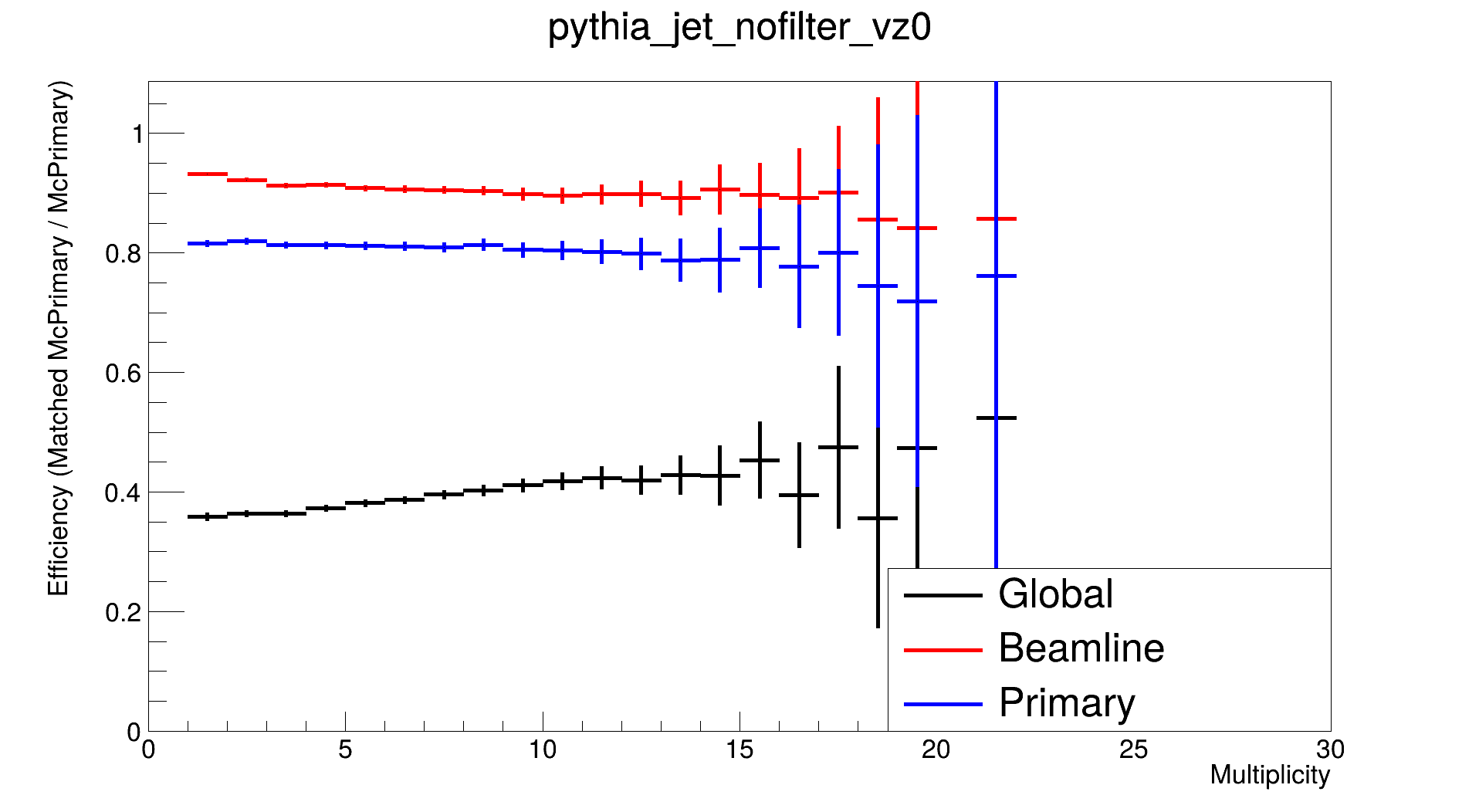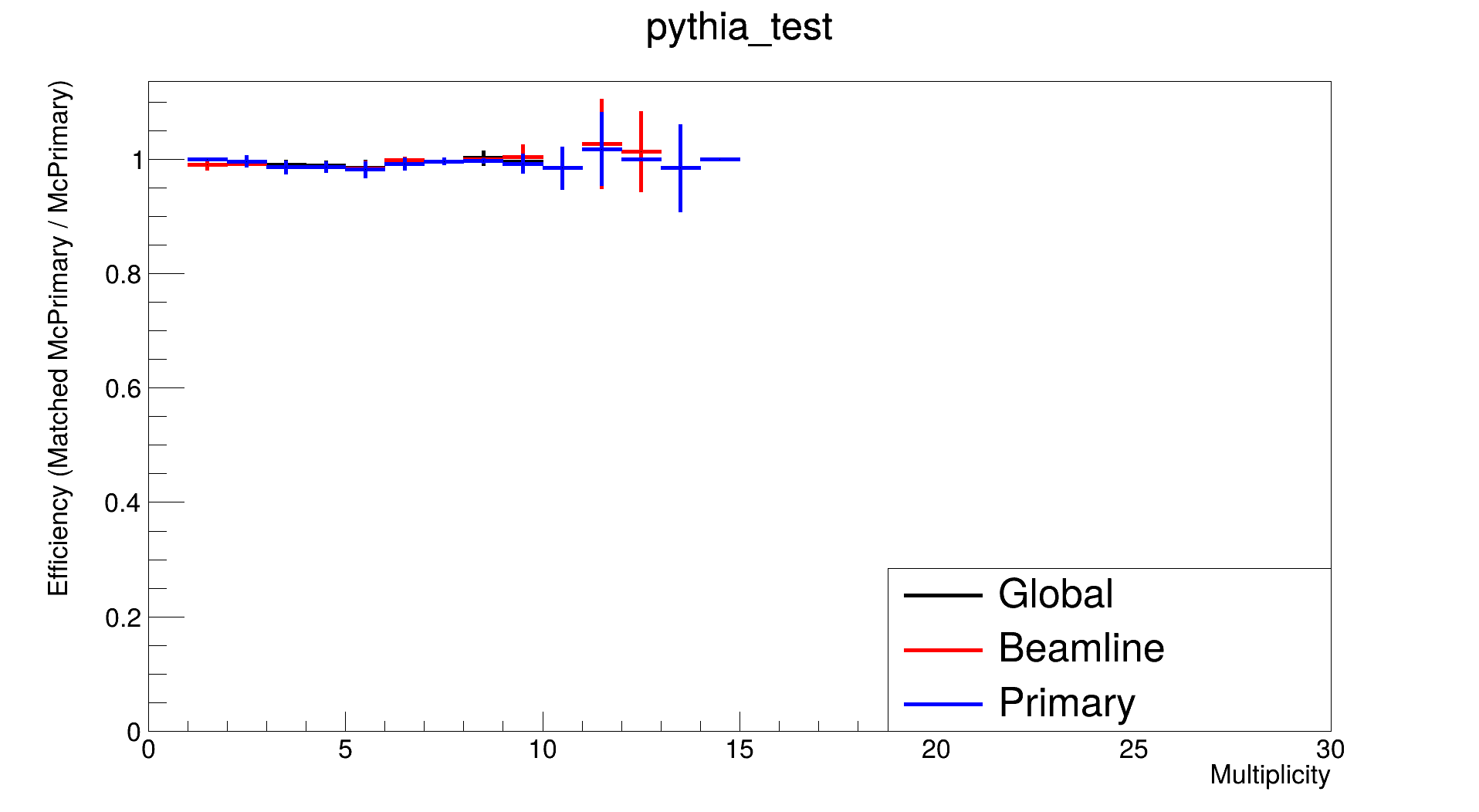star-fwd-software-l AT lists.bnl.gov
Subject: FWD Software
List archive
Re: [[Star-fwd-software-l] ] Pythia & Data samples
- From: "Brandenburg, Daniel" <brandenburg.89 AT osu.edu>
- To: "Schmookler, Barak A" <baschmoo AT Central.UH.EDU>, "star-fwd-software-l AT lists.bnl.gov" <star-fwd-software-l AT lists.bnl.gov>
- Subject: Re: [[Star-fwd-software-l] ] Pythia & Data samples
- Date: Thu, 7 Aug 2025 20:13:14 +0000
Hi Barak,
Sorry I missed this email before.
TLDR:
The global track (with FST points only) do not converge because the seed state is already fully consistent with the measurements - so the change in chi2 is never large enough to signal convergence.
Yes this is a bit different. To be more clear,
The track finding efficiency is very high now and I have made each track type (global, beam line, primary ) separate - previously global were fit first and then used as the seed for others.
So now the efficiency of the track finding is directly the starting point of each track fitting step. In the past I needed to use a bad initial momentum (0,0,10) to get the global track fits to “converge” because this initial state is so far from the measurement
that the chi2 changes a lot. But using a good initial momentum and charge drastically improved the beam line and primary track performance in full Pythia events, so I decided to go with that.
Since I save failed tracks, even the global tracks are in the picodst with status 0 and chi2 of zero.
hopefully that’s a little clearer.
Best,
Daniel
From: Schmookler, Barak A <baschmoo AT Central.UH.EDU>
Sent: Tuesday, August 5, 2025 11:10:34 AM
To: star-fwd-software-l AT lists.bnl.gov <star-fwd-software-l AT lists.bnl.gov>; Brandenburg, Daniel <brandenburg.89 AT osu.edu>
Subject: Re: Pythia & Data samples
Sent: Tuesday, August 5, 2025 11:10:34 AM
To: star-fwd-software-l AT lists.bnl.gov <star-fwd-software-l AT lists.bnl.gov>; Brandenburg, Daniel <brandenburg.89 AT osu.edu>
Subject: Re: Pythia & Data samples
Hi Daniel, Thanks! I'll run my previous MIP analysis on these files and send you the results. Do you understand why the efficiency (vs. multiplicity) for the global tracks is close to 40% in the latest results? This is very different from the
Hi Daniel,
Thanks! I'll run my previous MIP analysis on these files and send you the results.
Do you understand why the efficiency (vs. multiplicity) for the global tracks is close to 40% in the latest results? This is very different from the global tracks efficiency in the earlier email.
Best,
Barak
From: star-fwd-software-l-request AT lists.bnl.gov <star-fwd-software-l-request AT lists.bnl.gov> on behalf of "Brandenburg, Daniel" <star-fwd-software-l AT lists.bnl.gov>
Sent: Monday, August 4, 2025 10:08 PM
To: star-fwd-software-l AT lists.bnl.gov <star-fwd-software-l AT lists.bnl.gov>
Subject: Re: [[Star-fwd-software-l] ] Pythia & Data samples
Sent: Monday, August 4, 2025 10:08 PM
To: star-fwd-software-l AT lists.bnl.gov <star-fwd-software-l AT lists.bnl.gov>
Subject: Re: [[Star-fwd-software-l] ] Pythia & Data samples
Hi All,
All jobs have finished.
-
In the Run22 dataset I see no zombie files and 60,683,213 events
-
Updated performance plots with a bit more statistics from the pythia productions
-
Most importantly, beamline tracks have ~90% efficiency, charge id is much improved and platues at a usable rate ~35% misidentification.
-
Pythia samples all appear to have full statistics as well
Please let me know if you see any issues, and even better, please let me know if you have any results from these productions that can be highlighted in the collaboration meeting coming ip. Thank you
Best,
Daniel



Daniel Brandenburg
Assistant Professor
College of Arts and Sciences
Department of Physics
Ohio State University
From: star-fwd-software-l-request AT lists.bnl.gov <star-fwd-software-l-request AT lists.bnl.gov> on behalf of "Brandenburg, Daniel" <star-fwd-software-l AT lists.bnl.gov>
Date: Monday, August 4, 2025 at 10:33 AM
To: star-fwd-software-l AT lists.bnl.gov <star-fwd-software-l AT lists.bnl.gov>
Subject: [[Star-fwd-software-l] ] Pythia & Data samples
Date: Monday, August 4, 2025 at 10:33 AM
To: star-fwd-software-l AT lists.bnl.gov <star-fwd-software-l AT lists.bnl.gov>
Subject: [[Star-fwd-software-l] ] Pythia & Data samples
This Message Is From an External Sender
This message came from outside your organization.
Hi All,
Last week a made a few more substantial improvements to the tracking, especially in full events (e.g. Pythia and low luminosity data). Some details for those interested below.
Locations:
Pythia: /gpfs01/star/pwg_tasks/FwdCalib/PROD/Pythia
-
/gpfs01/star/pwg_tasks/FwdCalib/PROD/Pythia/pythia_dybg_vz0/
-
/gpfs01/star/pwg_tasks/FwdCalib/PROD/Pythia/pythia_dy_vz0/
-
/gpfs01/star/pwg_tasks/FwdCalib/PROD/Pythia/pythia_jet_nofilter_vz0/
-
/gpfs01/star/pwg_tasks/FwdCalib/PROD/Pythia/pythia_JPsi_vz0/
Run22 Low Luminosity: /gpfs01/star/pwg_tasks/FwdCalib/PROD/forwardCrossSection_2022/04082025
Note: some are still running, but all should be done by today sometime.
Tracking improvements:
-
Modify Kalman filter to use sqrt formalism to ensure pos def con matrices even in numerically unstable regions
-
Align reference planes with the direction of largest error for FST spacepoints
-
Seed track charge based on curvature estimate using only the extremum points (e.g. beamline + outermost FST)
-
Plots below show significant improvement in charge misid, momentum resolution, and mult dep efficiency



Daniel Brandenburg
Assistant Professor
College of Arts and Sciences
Department of Physics
Ohio State University
-
[[Star-fwd-software-l] ] Pythia & Data samples,
Brandenburg, Daniel, 08/04/2025
-
Re: [[Star-fwd-software-l] ] Pythia & Data samples,
Brandenburg, Daniel, 08/04/2025
-
Re: [[Star-fwd-software-l] ] Pythia & Data samples,
Schmookler, Barak A, 08/05/2025
- Re: [[Star-fwd-software-l] ] Pythia & Data samples, Brandenburg, Daniel, 08/07/2025
-
Re: [[Star-fwd-software-l] ] Pythia & Data samples,
Schmookler, Barak A, 08/05/2025
-
Re: [[Star-fwd-software-l] ] Pythia & Data samples,
Brandenburg, Daniel, 08/04/2025
Archive powered by MHonArc 2.6.24.